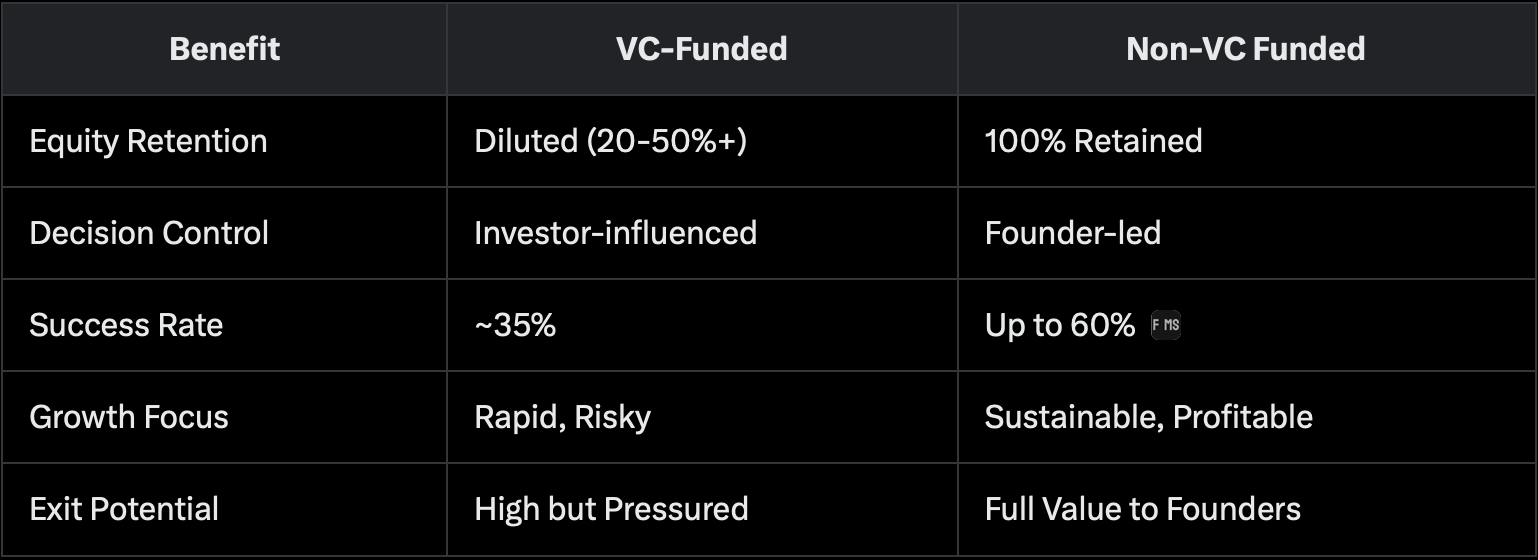The startup ecosystem is undergoing a transformation, and more founders are opting for paths that offer greater autonomy and sustainability. But why are so many choosing non-VC routes like bootstrapping or community funding?
Founders are increasingly choosing non-VC paths because they provide complete control over the business direction without the pressure to scale at breakneck speeds that often lead to burnout or failure. For instance, bootstrapping emphasizes slower, more sustainable growth, allowing entrepreneurs to retain 100% ownership and make decisions based on customer needs rather than investor demands. One significant advantage is the higher likelihood of success: bootstrapped ventures boast a 60% success rate, nearly double the 35% for VC-funded counterparts. Moreover, avoiding VC means sidestepping equity dilution and the short-term return pressures that can force risky pivots or sacrifice profitability. Here are the key reasons why founders are making this switch:
• Eliminating board seats for investors gives founders complete control over their company.
• This ensures that growth aligns with the founders’ vision.
• Decisions are made with real users in mind, leading to better products and increased customer loyalty.
• Without the pressure of large funding rounds, founders can avoid the “go big or go home” mentality.
• This allows for organic and profitable scaling.
• Data indicates that bootstrapped companies often outlast VC-backed ones.
• This is because bootstrapped companies prioritize fundamental aspects.
This shift reflects a broader trend: In 2025, with VC funding tightening, “seed-strapping” (a hybrid of seeding and bootstrapping) is gaining traction as founders seek independence amidst economic uncertainty.
Community-Powered Funding Models
Community-powered funding models revolutionize traditional financing by involving your audience, customers, and supporters directly. These models not only provide capital but also foster a loyal ecosystem that drives ongoing growth.
Customer-Funded Growth
Customer-funded growth involves utilizing revenue from early sales to bootstrap operations, creating a self-sustaining cycle. Instead of seeking venture capital (VC) funding, founders pitch to customers—pre-selling products, offering subscriptions, or crowdfunding through platforms like Kickstarter. This approach ensures product-market fit from the beginning and minimizes debt.
For instance, startups like Notion and Airtable have successfully utilized user feedback and pre-payments to iterate and expand without relying on external capital. This approach offers immediate validation and a built-in marketing engine through word-of-mouth.
Revenue-based financing (RBF) provides upfront capital in exchange for a percentage of future revenues until the investment is repaid, often with a cap. It’s particularly suitable for Software as a Service (SaaS) or e-commerce businesses with predictable income streams. Unlike traditional loans, RBF repayments are flexible and align with your earnings, reducing financial strain during slow periods.
Real-world examples include companies utilizing RBF for inventory or marketing, such as those partnered with firms like Riverside, where repayments are directly tied to business growth. This model has gained significant popularity, providing non-dilutive funding that preserves equity.
Community investment pools funds from supporters, often through bonds, funds, or equity crowdfunding, for social or local impact. Platforms like Republic or local community investment funds enable everyday investors to back startups, combining financial returns with mission-driven support.
Successes include social enterprises leveraging community bonds for expansion, as exemplified by models from the Canadian CED Network, where funds prioritize social returns alongside profits.
This approach cultivates profound loyalty, transforming investors into enthusiastic advocates.## Growth Without Venture Capital (VC) Scaling without venture capital (VC) necessitates strategic, sustainable approaches that prioritize efficiency and organic growth over mere hype.### Sustainable Scaling Strategies Prioritize high-return tactics such as content marketing, search engine optimization (SEO), and strategic partnerships to drive growth without depleting cash reserves. Prioritize customer retention by providing exceptional service, automating processes using no-code tools, and expanding into new markets methodically.
Key strategies include:
• Content and SEO-Driven Marketing: Create valuable resources to attract organic traffic.
• Partnerships and Affiliates: Collaborate for mutual growth without heavy ad spend.
• Efficient Operations: Utilize AI and automation to scale teams efficiently.
• Customer Feedback Loops: Iterate based on user input for sustainable product development.
These methods ensure profitability from the start, as demonstrated by bootstrapped firms that achieve steady ARR growth.
Success Stories
Proof is in the profits: Numerous million-dollar companies have thrived without venture capital, proving that community-powered paths can be successful.
• Basecamp is a project management tool that achieved millions in revenue through bootstrapping.
• It emphasizes work-life balance and customer focus.
• Tally is a no-code form builder that bootstrapped to $2 million ARR in 2025.
• It has a lean team and customer revenue.
• Palo Alto Software grew to millions without investors.
• It is the creator of business planning tools like LivePlan.
• RXBar is a protein bar company that sold for $600 million after bootstrapping.
• It focused on simple, customer-driven products.
These stories demonstrate that with discipline, startups can achieve over $1 million in annual recurring revenue (ARR); a feat accomplished by only 4% of startups, but often achieved by bootstrappers. However, this is where venture capitalists often fall short.
Building Your Alternative Path
Ready to embark on a community-powered journey? Follow these steps to nurture growth within your ecosystem.
Steps to Community-Powered Growth
- Define Your Identity and Mission: Clearly articulate your problem-solving vision to attract like-minded individuals who share your passion.
- Identify and Engage Early Adopters: Identify 10-20 potential community members through social media platforms or events. Provide value to these individuals by offering educational resources or workshops.
- Establish Platforms for Interaction: Utilize platforms such as Discord, Reddit, or newsletters to facilitate open communication and support within your community.
- Offer Educational Content: Host webinars or workshops to foster learning and loyalty among your community members.
- Monetize and Scale: Launch customer-funded initiatives, such as pre-sales, to generate initial revenue. Subsequently, transition to revenue-based funding (RBF) or attract investments to scale your business.
- Measure and Iterate: Track the engagement and revenue impact of your community-powered efforts. Analyze the data to make informed adjustments and optimize your strategies for continued growth.
Financial Advantages: Choosing non-venture capital funding isn’t just about avoiding dilution; it’s about building wealth on solid ground. Benefits of Non-VC FundingNon-venture capital paths like bootstrapping preserve full equity, allowing founders to retain 100% of exits or profits. By eliminating repayment obligations, founders can focus on profitability from the beginning, leading to more stable financial conditions. Grants and community funds provide non-dilutive capital, while RBF offers flexibility without ownership loss.

These advantages make non-VC the smarter choice for many in 2025. Community-powered startups demonstrate that sustainable and profitable growth doesn’t necessitate venture capital dilution. By leveraging the power of your audience and prioritizing genuine value, you can build a million-dollar business that endures. Ready to bootstrap your way to success?
Begin small, embrace community, and witness your startup flourish.
